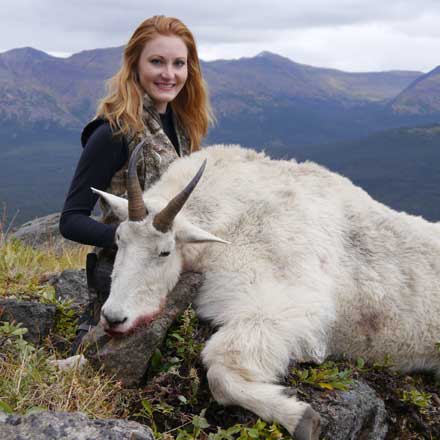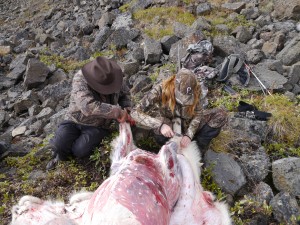
Hunting the Rocky Mountain goat has been a dream of mine for many years. I first saw a mount of the animal at a hunting convention and thought it was the closest looking thing to a polar bear that I would ever be able to hunt. The opportunity to go to British Columbia with my dad came up unexpectedly, and I jumped at the chance. We would be hunting in northern British Columbia outside Smithers with an outfitter called Love Brothers and Lee. It was a walk down memory lane for my dad because he first hunted the Rocky Mountain goat with his dad in a similar area over 40 years ago.
It has been some time since my last hunt alone with my dad, maybe 4 years or longer, so I was very excited. The guys at Legendary Arms Works built a .280 for me to shoot on the hunt; it was one of the first guns built by the new company. Mark Bansner has been building guns for over 40 years and has joined forces with our good friend Dave Dunn to form the new firearm manufacturing company, Legendary Arms
Works. This would be the first hunt with one of their guns, and we were excited to try them out. I had never done a North American mountain hunt before, and I was concerned that I would struggle with the physical demands of the hunt. I tried to exercise and stay in shape prior to the hunt, but no training in Los Angeles could prepare me for the serious mountains of BC.
The camp is on a little lake called Duti Lake and is only accessible by float plane. This means that the resident pressure is non-existent. It is a peaceful and beautiful place. There is no running water or electricity although they have figured out how to get the stream and lake water to flow into the kitchen sink, and they have a generator to give everyone enough power to get a nice hot shower every now and then. We were there just in time to watch the colors change across the mountain range. Every morning we awoke to new and beautiful colors. We arrived mid-day and went to sight in the rifles along the lake shore. I had never fired the .280 before, but it shot like a dream. It has very little recoil, and yet it was light weight, perfect for a mountain hunt. I especially like the controlled round feed action. It makes the reloading so precise and dependable.
The plan was simple. We got up each morning, sat at the lake shore, and glassed the mountains across the lake. I was only after the Rocky Mountain goat, but my dad had tags for black bear and caribou. The goats were not too...
difficult to see since there was no snow up there yet. The most difficult part was making sure that what we had in our
binoculars was a goat and not a rock. On day 2 we spotted a goat at the top of a rocky mountain and decided to give it a try. Our guide, Ron Fleming, estimated that, at the worst, it would take us till about 4pm to get to where that goat was resting. Fortunately, it wasn’t getting dark until around 7, and that gave us time to get down as well. We packed up and started up the mountain. The hike was not as bad as I expected- at first.

We hit the timber line and started to cut upwards through
the forest. It was so pretty, but we kept seeing bear droppings and broken trees where bears had been scratching, which was a little unnerving.
The really scary part came about halfway up the mountain when we hit a band of shale that we needed to cross. I have always been weary of shale. I remember when I hunted my Thar in New Zealand. After I shot the Thar, it jumped up onto a rocky outcrop and fell into a shale slide, then sailed right past us down the hill. We were lucky that it didn’t get damaged in the fall, but the memory of the uncontrolled slide stuck with me. I was very hesitant stepping into the shale, which it turns out is the worst way to step into it. I sunk, I crawled, and I swam through the sinking and sliding shale in the least lady like fashion imaginable. I was so frustrated with myself. The best advice I got later in the trip was to balance on your feet with your feet at the same angle as the mountain. This gives you the most traction and gets you across quickly with your weight evenly balanced. This advice came from the outfitter’s wife, Brenda. This advice totally contradicts all other advice I had been given, like using my walking stick to brace myself, or putting a hand down, or sliding with the shale, but man did it work!
Unfortunately, that day I had no clue how to walk in that shale, so spent a lot of time on my hands and knees. The scariest parts were where the shale washed out to a shear drop.
I kept picturing myself launching over the edge of the drop and sailing out into the treacherous rocks below. Moving forward was the goal, so I...
struggled, but I kept pushing forward. There were very few spots where we could glass the goats that we had seen from across the lake. They were basically strait above us and off to the right in a bend that made them impossible to see from below.

We got up to the general area where we had seen the goats, and all we had was hope that they were still there. We were working our way through some particularly nasty rocks and shale when Ron spotted the goats.
They had moved to the right and out of the bend that had concealed them, and they were visible with the naked eye for the first time. We estimated that they were about 600 yards away, but moving closer. They could see us if they looked up, so we had to time our movements to match their feeding. The one big Billy was the closest. Every time it took a bite, we would make a move to get around the nasty rocks. Once everyone was around the rocks, we had some cover behind a bend to make our approach. Everyone was exhausted. I could hear the heavy breathing from all the members of our group, but we knew we had one last push to get to the top of the ridge we were on in order to get a shot. We pushed onward and upward in a final flurry, and when we reached the top, Ron signaled to my dad to take the lead.
He wanted my dad to be the one to help get me in shooting position. He said later that he thought it was only right since my dad had been with his dad when he took his first shot on a Rocky Mountain goat. We crept up to the low saddle in the ridge, and my dad slid his pack out in front of me. I slowly slid my rifle over the pack and peeked out over the ridge for the first time. The goat was standing broadside, feeding at around 100 yards. Perfect! I steadied myself and tried to catch my breath enough to make a solid shot. When I was comfortable, my dad gave me the go ahead to shoot. I heard the bullet hit with a solid thud, and I quickly reloaded. I was ready to take another shot, but Ron whispered from behind us to wait.
The goat stayed on its feet, but swayed dramatically. My dad gave me the ok to shoot again, but then I heard again from behind that I should wait. I was getting serious mixed signals, but the guys couldn’t hear what...
the other one was saying. I hesitated and asked again about taking a second shot. This time I got a firm yes from my dad, and I squeezed the trigger. This shot sent the goat tumbling end over end down the hill. I instantly knew why Ron had wanted to me to wait. If the goat didn’t slow its roll it would launch off the mountain and surely be destroyed by the fall. I got lucky. The goat was stopped by a rock quarry below that we had not yet seen.
We hurried over, and the goat was still in perfect condition. The fall had not destroyed the trophy. The second shot is a difficult call in mountain hunting because if the first shot is not perfect ,and the animal runs, it can get into places that humans simply can’t access. A follow up shot can save a ton of climbing and tracking, but a second shot could cause a tumble. The hunt was a success. The second shot may or may not have been necessary, but it worked perfectly in this situation. On our way down the mountain, Ron pointed out that the second shot is always risky because if they fall, they can fall a long, long, long way down. I will definitely remember this lesson for future mountain hunts.